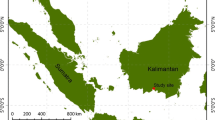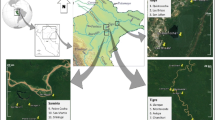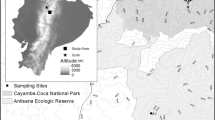Abstract
Peatlands are unique wetland ecosystems that provide various ecosystem services such as carbon storage and biogeochemical cycling, however being threatened by anthropogenic activities. The present study was conducted to explore the impact of land use conversion on carbon stocks and peat properties in a tropical peatland in the Leyte Sab-a Basin Peatland (LSBP) in Northeastern Leyte, Philippines. The carbon stocks (aboveground and belowground) and physico-chemical properties of peat soil were compared among peat swamp forest, grassland and peatland with cultivation. Land use conversion resulted in the significant reduction of the total aboveground carbon stock. The peat swamp forest had the highest carbon stocks (38.56 ± 4.58 Mg ha−1), and when converted to grassland and peatland with cultivation, it has resulted to carbon loss of as much as 86.59 and 90.45%, respectively. The belowground root carbon stock was highest in the peat swamp forest (5.05 ± 0.64 Mg ha−1), also while highest peat carbon stock (1 m depth) was observed in the cultivation areas (45.28 ± 2.25 – 61.27 ± 3.07 Mg ha−1). However, peat swamp forests with very deep peat deposits potentially store a significant amount of carbon than in peatland with cultivation that was characterized by shallower compressed peats. In addition, land use conversion altered the physico-chemical properties of peat such as water content, organic matter, and porosity, and bulk density which all indicated peatland degradation. Finally, the overall result of this study highlights the importance to develop and implement management and conservation plans for LSBP.







Similar content being viewed by others
Data Availability
Interested party may request data and materials from the corresponding author.
Code Availability
Not applicable.
References
Adame MF, Santini NS, Tovilla C, Vázquez-Lule A, Castro L, Guevara M (2015) Carbon stocks and soil sequestration rates of tropical riverine wetlands. Biogeosciences 12:3805–3818. https://doi.org/10.5194/bg-12-3805-2015
Agus F, Hairiah K, Mulyani A (2011) Measuring carbon stock in peat soils: practical guidelines. Bogor, Indonesia: World Agroforestry Centre (ICRAF) Southeast Asia Regional Program, Indonesian Centre for Agricultural Land Resources Research and Development, pp 1-60
Alibo VLB, Lasco RD (2012) Carbon storage of Caimpugan Peatland in Agusan Marsh, Philippines and its role in greenhouse gas mitigation. Journal of Environmental Science and Management 15:50–58
Andriesse JP (1988) Nature and management of tropical peat soils. FAO Soils Bulletin 59:165
Anshari GZ, Afifudin M, Nuriman M, Gusmayanti E, Arianie L, Susana R, Nusantara RW, Sugardjito J, Rafiastanto A (2010) Drainage and land use impacts on changes in selected peat properties and peat degradation in West Kalimantan Province, Indonesia. Biogeosciences 7:3403–3419. https://doi.org/10.5194/bg-7-3403-2010
Aribal LG, Fernando ES (2014) Vascular plants of the peat swamp forest in Caimpugan, Agusan del Sur Province on Mindanao Island, Philippines. Asian Journal of Biodiversity 5:1–17. https://doi.org/10.7828/ajob.v5i1.478
Aribal LG, Fernando ES (2018) Plant diversity and structure of the Caimpugan peat swamp forest on Mindanao Island, Philippines. Mires and Peat 22:1–16. https://doi.org/10.19189/MaP.2017.OMB.309
ASEAN Peatland Forests Project (2018) Sustainable management of peatland forests in Southeast Asia. Retrieved 15 April, 2019, from http://www.aseanpeat.net/newsmaster.cfm?&menuid=11&action=view&retrieveid=56
Bader C, Müller M, Schulin R, Leifeld J (2018) Peat decomposability in managed organic soils in relation to land use, organic matter composition and temperature. Biogeosciences 15:703–719. https://doi.org/10.5194/bg-15-703-2018
Brown JK (1974) Handbook for inventorying downed woody material. General Technical Report GTR-INT-16. USDA Forest Service, Missoula
Cairns MA, Brown S, Helmer EH, Baumgardner GA (1997) Root biomass allocation in the world’s upland forests. Oecologia 111:1–11
Chave J, Réjou - Méchain M, Búrquez A, Chidumayo E, Colgan MS, Delitti WBC, Duque A, Eid T, Fearnside PM, Goodman RC, Henry M, Martínez - Yrízar A, Mugasha WA, Landau HCM, Mencuccini M, Nelson BW, Ngomanda A, Nogueira EM, Ortiz-Malavassi E, Pélissier R, Ploton P, Ryan CM, Saldarriaga JG, Vieilledent G (2014) Improved allometric models to estimate the aboveground biomass of tropical trees. Global Change Biology 20:3177–3190. https://doi.org/10.1111/gcb.12629
Clarke D, Rieley JO (2019) Strategy for responsible peatland management. 6 Edition, International Peatland Society, Jyväskylä, Finland, pp 35
Dayathilake DDTL, Lokupitiya E, Wijeratne VPIS (2020) Estimation of aboveground and belowground carbon stocks in urban freshwater wetlands of Sri Lanka. Carbon Balance Manag 15:1–10. https://doi.org/10.1186/s13021-020-00152-5
Decena SCP, Avorque CA, Decena ICP, Asis PD, Pacle B (2020) Impact of habitat alteration on amphibian diversity and species composition in a lowland tropical rainforest in Northeastern Leyte, Philippines. Scientific Reports 10:10547. https://doi.org/10.1038/s41598-020-67512-6
Frank S, Tiemeyer B, Gelbrecht J, Freibauer A (2014) High soil solution carbon and nitrogen concentrations in a drained Atlantic bog are reduced to natural levels by 10 years of rewetting. Biogeosciences 11:2309–2324. https://doi.org/10.5194/bg-11-2309-2014
Garcia PP, Bayr M, Manigo AC, Lumbre JF, Decena SCP, Arribado AO (2021) Geoinformatics study of Leyte Sab-a Basin Peatland. Terminal report submitted to the Forest Foundation of the Philippines
Grønlund A, Hauge A, Hovde A, Rasse DP (2008) Carbon loss estimates from cultivated peat soils in Norway: a comparison of three methods. Nutrient Cycling in Agroecosystems 81:157–167. https://doi.org/10.1007/s10705-008-9171-5
Guillaume T, Holtkamp AM, Damris M, Brümmer B, Kuzyakov Y (2016) Soil degradation in oil palm and rubber plantations under land resource scarcity. Agriculture Ecosystems and Environment 232:110–118. https://doi.org/10.1016/j.agee.2016.07.002
Hairiah K, Sulistyani H, Suprayogo D, Widianto, Purnomosidhi P, Widodo RH, Noordwijk MV (2006) Litter layer residence time in forest and coffee agroforestry systems in Sumberjaya, West Lampung. Forest Ecology and Management 224:45–57. https://doi.org/10.1016/j.foreco.2005.12.007
Hammer Ø, Harper DAT, Ryan PD (2001) PAST: paleontological statistics software package for education and data analysis. Palaeontologia Electronica 4:1–9
Hergoualc’h K, Gutiérrez-Vélez VH, Menton M, Verchot LV (2017) Characterizing degradation of palm swamp peatlands from space and on the ground: an exploratory study in the Peruvian Amazon. Forest Ecology and Management 393:63–73. https://doi.org/10.1016/j.foreco.2017.03.016
Hergoualc’h K, Verchot LV (2011) Stocks and fluxes of carbon associated with land use change in Southeast Asian tropical peatlands: a review. Global Biogeochemical Cycles 25:1–13. https://doi.org/10.1029/2009GB003718
Hooijer A, Page S, Jauhiainen J, Lee WA, Lu XX, Idris A, Anshari G (2012) Subsidence and carbon loss in drained tropical peatlands. Biogeosciences 9:1053–1071. https://doi.org/10.5194/bg-9-1053-2012
Hoyos-Santillan J, Lomax BH, Large D, Turner BL, Boom A, Lopez OR, Sjögersten S (2015) Getting to the root of the problem: litter decomposition and peat formation in lowland Neotropical peatlands. Biogeochemistry 126:115–129. https://doi.org/10.1007/s10533-015-0147-7
Hoyos-Santillan J, Lomax BH, Large D, Turner BL, Boom A, Lopez OR, Sjögersten S (2016) Quality not quantity: organic matter composition controls of CO2 and CH4 fluxes in neotropical peat profiles. Soil Biology and Biochemistry 103:86–96. https://doi.org/10.1016/j.soilbio.2016.08.017
Intergovernmental Panel on Climate Change (2006) Good practice guidelines for National Greenhouse gas inventories. Switzerland
Jaafar WSWM, Said NFS, Maulud KNA, Uning R, Latif MT, Kamarulzaman AMM, Mohan M, Pradhan B, Saad SNM, Broadbent EN, Cardil A, Silva CA, Takrif MS (2020) Carbon emissions from oil palm induced forest and peatland conversion in Sabah and Sarawak, Malaysia. Forests 11:1–22. https://doi.org/10.3390/f11121285
Kauffman JB, Heider C, Cole TG, Dwire KA, Donato DC (2011) Ecosystem carbon stocks of Micronesian mangrove forests. Wetlands 31:343–352. https://doi.org/10.1007/s13157-011-0148-9
Könönen M, Jauhiainen J, Laiho R, Kusin K, Vasander H (2015) Physical and chemical properties of tropical peat under stabilised land uses. Mires and Peat 16:1–13
Krüger JP, Leifeld J, Glatzel S, Szidat S, Alewell C (2015) Biogeochemical indicators of peatland degradation –a case study of a temperate bog in northern Germany. Biogeosciences 12:2861–2871. https://doi.org/10.5194/bg-12-2861-2015
Lampela M, Jauhiainen J, Vasander H (2014) Surface peat structure and chemistry in a tropical peat swamp forest. Plant Soil 382:329–347. https://doi.org/10.1007/s11104-014-2187-5
Leifeld J, Klein K, Wüst-Galley C (2020) Soil organic matter stoichiometry as indicator for peatland degradation. Scientific Reports 10:7634. https://doi.org/10.1038/s41598-020-64275-y
Leifeld J, Menichetti L (2018) The underappreciated potential of peatlands in global climate change mitigation strategies. Nature Communcations 9:1–7. https://doi.org/10.1038/s41467-018-03406-6
Madeira BG, Espírito-Santo MM, Neto SD’, Nunes YRF, Azofeifa GAS, Fernandes GW, Quesada M (2009) Changes in tree and liana communities along a successional gradient in a tropical dry forest in south-eastern Brazil. Plant Ecology 201:291–304. https://doi.org/10.1007/s11258-009-9580-9
Manuri S, Brack C, Nugroho NP, Hergoualc’h K, Novita N, Dotzauer H, Verchot L, Putra CAS, Widyasari E (2014) Tree biomass equations for tropical peat swamp forest ecosystems in Indonesia. Forest Ecology and Management 334:241–253. https://doi.org/10.1016/j.foreco.2014.08.031
Martin AR, Thomas SC (2011) A reassessment of carbon content in tropical trees. PLoS ONE 6:e23533. https://doi.org/10.1371/journal.pone.0023533
Miettinen J, Liew SC (2010) Status of peatland degradation and development in Sumatra and Kalimantan. Ambio 39:394–401. https://doi.org/10.1007/s13280-010-0051-2
Murdiyarso D, Donato D, Kauffman JB, Kurnianto S, Stidham M, Kanninen M (2009) Carbon storage in mangrove and peatland ecosystems: a preliminary account from plots in Indonesia. Working Paper, pp 1-35
Murdiyarso M, Kauffman B (2015) Carbon stock assessment in tropical peat swamp forest [PowerPoint presentation]. In:SWAMP toolbox: Theme C section C2. Retrieved from https://www.cifor.org/swamp-toolbox. Accessed 4 Mar 2021
Novita N, Kauffman JB, Hergoualc’h K, Murdiyarso D, Tryanto DH, Jupesta J (2021) Carbon stocks from peat swamp forest and oil palm plantation in Central Kalimantan, Indonesia. In: Djalante R et al (eds) Climate Change Research, Policy and Actions in Indonesia. Springer Climate, pp 203–227
Page S, Wüst R, Banks C (2010) Past and present carbon accumulation and loss in Southeast Asian peatlands. Science Highlights: Peatlands 18:25–27
Pelser PB, Barcelona JF, Nickrent DL (2011) Co’s Digital Flora of the Philippines. Retrieved 25 January, 2021, from https://www.cifor.org/swamp-toolbox
Petrova S, Dushku A, Harris N, Walker S (2008) Application of multispectral aerial digital imagery for estimating carbon stocks in the Mawas peat forest. Winrock International, Report
Quiñones CMO, Asio VB (2015) Soils derived from ophiolitic rocks in northeastern Leyte: morphological, physical, and chemical properties. Annals of Tropical Research 37:36–56
Rahgozar MA, Saberian M (2015) Physical and chemical properties of two Iranian peat types. Mires and Peat 16:1–17
Rezanezhad F, Price JS, Quinton WL, Lennartz B, Milojevic T, Cappellen PV (2016) Structure of peat soils and implications for water storage, flow and solute transport: a review update for geochemists. Chemical Geology 429:75–84. https://doi.org/10.1016/j.chemgeo.2016.03.010
Rowell D (1994) The arrangement of particles and pores: soil structure. In: Rowell, D. 601 (editor), Soil Science: Methods and Applications. Essex, England, Longman Scientific and 602 Technical, pp 61
Sitoe AA, Mandlate LJC, Guedes BS (2014) Biomass and carbon stocks of Sofala Bay mangrove forests. Forests 5:1967–1981. https://doi.org/10.3390/f5081967
Suerte LO, Yumul GP Jr, Tamayo RA Jr, Dimalanta CB, Zhou M-F, Maury RC, Polvé M, Balce CL (2005) Geology, geochemistry and U-Pb SHRIMP age of the Tacloban Ophiolite Complex, Leyte Island (Central Philippines): implications for the existence and extent of the proto-Philippine sea plate. Resource Geology 55:207–216
Tandang DN, Tadiosa ER, Andres AP (2014) A pictorial handbook on peat swamp flora of Agusan Marsh, Mindanao. Peat Swamp Forest Project, IFAD/GEF EU Funded, 2014. pp 329
Tonks AJ, Aplin P, Beriro DJ, Cooper H, Evers S, Vane CH, Sjögersten S (2017) Impacts of conversion of tropical peat swamp forest to oil palm plantation on peat organic chemistry, physical properties and carbon stocks. Geoderma 289:36–45. https://doi.org/10.1016/j.geoderma.2016.11.018
Upton A, Vane CH, Girkin N, Turner BL, Sjögersten S (2018) Does litter input determine carbon storage and peat organic chemistry in tropical peatlands? Geoderma 326:76–87
Verwer CC, van der Meer PJ (2010) Carbon pools in tropical peat forest: towards a reference value for forest biomass carbon in relatively undisturbed peat swamp forest in Southeast Asia. Alterra Report 2108, Alterra Wageningen
Yonebayashi K, Pechayapisit J, Vijarnsorn P, Zahari AB, Kyuma K (1994) Chemical alterations of tropical peat soils determined by Waksman’s proximate analysis and properties of humic acids. Soil Science and Plant Nutrition 40:435–444. https://doi.org/10.1080/00380768.1994.10413321
Zanne AE, Lopez-Gonzalez G, Coomes DA, Ilic J, Jansen S, Lewis SL, Miller RB, Swenson NG, Wiemann MC, Chave J (2009) Global wood density database. Dryad. Identifier: http://hdl.handle.net/10255/dryad.235. Accessed 18 Nov 2020
Acknowledgements
The authors are grateful to the Forest Foundation of the Philippines (FFP) for providing the necessary funds through the International Institute of Rural Reconstruction (IIRR). We are thankful to the following people as our field guides and labourers; Angelo Agamon, Richmond Matobato, Igmedio Guersola, Dioscoro Oliver, and Atilano Avestruz. We are also thankful to Jerome L. Montemayor, Juvilyn V. Salazar, Magnolia Rosimo and the rest of the IIRR team for the continues support of the research. Lastly, we acknowledge Dr. Edwino S. Fernando, Dr. Ernesto Militante, and two anonymous reviewers for their constructive comments on the earlier drafts of the manuscript.
Funding
The research was financially supported by the Forest Foundation of the Philippines (FFP) through the International Institute for Rural Reconstruction (IIRR).
Author information
Authors and Affiliations
Contributions
All the authors (SCPD, SVP, AOA, DM Jr., MSA, SSS, ESR) contributed significantly in the development of the manuscript. SCPD, AOA and SVP designed the study. The data collection and analyses were performed by all the authors. The initial draft of the manuscript was prepared by SCPD and all authors commented on it. All the authors contributed to the revision and approved the final version of the manuscript.
Corresponding author
Ethics declarations
Conflicts of Interest/Competing Interests
There are no conflicts of interest to disclose.
Ethics Approval
Not applicable.
Consent to Participate
Not applicable.
Consent for Publication
Not applicable.
Additional information
Publisher’s Note
Springer Nature remains neutral with regard to jurisdictional claims in published maps and institutional affiliations.
This article belongs to the Topical Collection: Peatlands.
Rights and permissions
About this article
Cite this article
Decena, S.C.P., Villacorta-Parilla, S., Arribado, A.O. et al. Impact of Land Use Conversion on Carbon Stocks and Selected Peat Physico-chemical Properties in the Leyte Sab-a Basin Peatland, Philippines. Wetlands 42, 2 (2022). https://doi.org/10.1007/s13157-021-01520-8
Received:
Accepted:
Published:
DOI: https://doi.org/10.1007/s13157-021-01520-8




